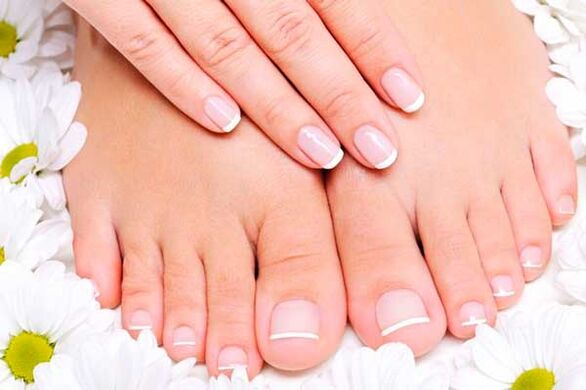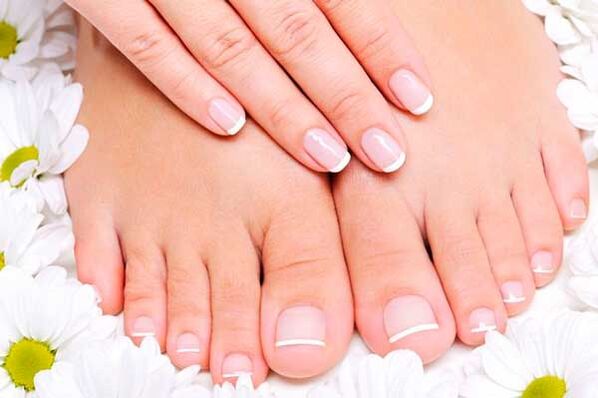
Toenail fungus is the most common and unpleasant disease. Fungal infections of the feet and nails are unlikely to cause significant harm to health, but cause a weakened immune system and unpleasant pain.
Nail fungus has the ability to concentrate toxins in the body, multiplying during the growth of pathogenic fungi, causing the body to be poisoned slowly, possibly causing allergies or exacerbating chronic diseases. As a result, metabolic processes in the body are disturbed, immunity decreases, the general physical condition worsens, and sensitivity to negative influences from the environment increases.
In this article, you will learn what fungal spores are, what causes this nasty disease, symptoms and signs of damage, how to treat toenail fungus at home, preventive measures to avoid spreading the infection. infected.
Why does tinea versicolor occur on toenails?
The appearance of a fungal infection can cause:
- wounds on the feet in the form of cracks and abrasions, which can be the result of a pedicure procedure or from wearing narrow, uncomfortable shoes;
- calves and calluses on the feet;
- often poor vacuum care;
- reduced immunity;
- long-term use of antibiotics and drugs with a similar effect on the body during treatment;
- excessive sweating of the feet;
Impaired immunity and the body's protective function can cause fungal diseases, but is not a major factor in the onset of the disease.
First of all, the infection occurs:
- Household way from contact with sick people, often relatives, through shared slippers or shoes, through household items - wipes, sponges, carpets;
- in saunas, baths, pools and on the beach. Crowds and humid environments contribute to the spread of fungal diseases;
- in any place where people walk without shoes. Spores of the fungus are resistant to sudden temperature changes from low to very high and survive for a long time in the sand, on the surface of sidewalks, on the top surfaces of swimming pools;
- when wearing someone else's shoes, in which the pathogenic virus microflora can live and multiply;
- wearing socks or stockings made of synthetic materials that do not allow air to pass through, creating a favorable microclimate for fungal infections;
- the constant wearing of false nails makes it impossible for the nails to breathe, which also contributes to the spread of fungal infections;
Symptoms of a fungal infection in the nails and feet
- dry, itchy, red and flaky skin of the feet;
- the appearance on the soles and between the toes of small itchy blisters, which may form corns;
- the appearance of diaper rash on the legs due to increased sweating;
- change the shape and color of the nails. The spores of the fungus penetrate the nail plate and gradually take root in it. The structure of the nail becomes heterogeneous, brittle, the surface is uneven. In defeated places, bright or yellow spots appear, and gaps under them;
- Under the effect of toxins secreted by fungal spores, feet sweat a lot, unpleasant odors appear;
- increase in body temperature is possible.
If there are cracks, itchiness, diaper rash, unpleasant odor on the feet, changes in the shape of the nails and the appearance of white or yellow spots on the surface and the spaces under them, then there is a direct reason. Contact a dermatologist for detailed advice and treatment plan. Your dermatologist will tell you everything about how to treat toenail fungus at home and prescribe the right medication for each specific case, as well as give advice on using herbal remedies.

Symptoms of the disease and the nature of the lesion depend on the type of fungal disease:
- tinea - vesicular, which begins to affect the lower part of the foot, is characterized by the appearance of small bubbles and fluid-filled blisters and the additional attachment of bacteria - pathogens;
- type of mycosis - membranous, characterized by the appearance on the skin between the toes of small erythematous nodules and the appearance of painful cracks;
- type of fungal disease - like moccasin, in which mycosis affects the skin of the feet, starting at the heels and ending with the toes. Lesions are accompanied by painful sensations, the skin of the feet thickens, cracks and itching appear.
Normally, the fungal spores from the soles of the feet spread to the fingernails, where the fungus takes root and grows in the nail, affecting it. Fungal infections negatively affect the entire body, inhibit its functions and can cause allergic reactions.
Treatment of toenail fungus at home: preparations against fungal diseases
The most effective home treatment for toenail fungus is a complex combination of antifungal drugs and folk remedies. First we will talk about the drugs used in the treatment of toenail fungus, then the folk methods.
Medicines must be used exactly as directed, dosing continuously and accurately. For the treatment of fungal diseases, there are special antifungal drugs with the required dosage. In severe cases and extensive lesions, the fungus can be eliminated in several stages, observing a certain pause between courses of treatment.
It is possible to cure fungus by medical methods with the help of cheap and very effective drugs. Antifungal medications are available as ointments, gels, and varnishes, which must be applied to the nail surface several times a day. The spores of the fungus are resistant to many different effects, to get rid of them completely, you will have to periodically change the drug treatment regimen and alternate between western and traditional medicine.
Treat toenail fungus with folk methods at home
Cure toenail fungus with folk methods at home is a way to periodically treat the fungal area with special remedies from nature. It is well known that fungi are afraid of acids, and the treatment of fungus with the help of nature is based on this fact. The most effective natural remedies are vinegar, hydrogen peroxide, propolis, baking soda, iodine, garlic, kombucha. These are only means of negatively affecting the pathogenic flora of the fungus and being able to cope with it.
Treat Toenail Fungus with Vinegar
Vinegar treatment is carried out using a lotion whose composition is specially made from vinegar, alcohol and glycerin. The ratio of ingredients to the appropriate amount is -2/2/1. A cotton ball or a cotton ball soaked in solution is applied to the affected area of the nail and kept for a certain time, then dry the feet with a clean towel or napkin, and only after a while wash the feet. with warm water. Topical should be applied for two weeks to a month, depending on the complexity of the lesion. During such treatment, the infected nail begins to scab and gradually disappears, and a new healthy nail grows in its place.
Important! To avoid burning the skin around the affected nail, you should lubricate the skin with any vegetable oil before applying the lotion.
Treat nail fungus with baking soda
Treatment with baking soda is done in the same way as with vinegar, for this you need to make a cold solution of baking soda, soak a cotton ball in it and put it on the affected nail for a while, then take a plateRemove and wipe the nail thoroughly with a dry towel.
Hydrogen peroxide fights nail fungus
Treatment with hydrogen peroxide is carried out as follows: peroxide must be poured into the space under the platinum nail, where the fungus has taken root. The powerful and disinfecting environment of peroxide perfectly destroys fungal spores and helps to quickly recover from the disease.
Iodine
Iodine treatment is very effective, this drug should be applied to the nail several times a day, and fungal cavities should also be treated with iodine.
Propolis
In the treatment of fungus with propolis, compresses from propolis tincture and alcohol will help a lot. The compress must be applied daily and kept for a certain time, then rinse the feet with warm water. Such treatment should be carried out until a positive result is obtained and the nail is renewed.
Other folk methods in the treatment of nail fungus
- Another effective but somewhat complicated recipe involves applying a mixture of one teaspoon of methyl phthalate, one tablespoon of vinegar, one teaspoon of vegetable oil, and two raw eggs to the affected area. Mix all ingredients well and keep refrigerated until fully used. Apply a piece of gauze from the mixture to the nail, cover the finger with plastic wrap, and put a wool sock on it. Hold for at least thirty minutes.
- As a homeopathic remedy, a living organism, Kombucha, will be of great help. During the night, apply a piece of kombucha to the affected nail and cover the area with cling film. Kombucha has an acidic environment and copes well with fungal spores.
- Good results are obtained by treating the affected surface daily with finely ground garlic. Garlic juice is a natural antiseptic and works great against fungal spores.
Treatment of toenail fungus at home needs to be done regularly and methodically. If an extremely small percentage of spores remain under the nail, the fungus will start to grow again and all treatment will have to start all over again.
To avoid fungal nail and foot infections, you need to follow the preventive measures that we will talk about later.
Disease prevention
- To avoid primary fungal infection or reinfection, regular thorough handling of all nail tools and accessories is required. If a manicure or pedicure takes place in a salon, make sure the owner does not use untreated tools after others.
- Periodically clean your shoes with disinfectants such as vinegar or formalin. For the best treatment effect in disinfecting shoes, mix these products together and proceed with treatment.
- Occasionally, disinfect common household and household items by boiling them in a soapy solution. For the solution, it is best to combine water, laundry soap and a small amount of baking soda;
- Access to the baths, sauna and swimming pool is only possible with special rubber slippers or flip flops.
- There are separate bath accessories - bath towels, sponges and towels.
- Regularly observe foot hygiene with the help of water procedures. You should soak your feet in warm water regularly, in which you can add a crystal of potassium permanganate or a teaspoon of baking soda as an antiseptic.
- Do not try on, let alone wear someone else's shoes, as they are considered the best vectors of fungal infections.
Successful home treatment of toenail fungus can only be achieved with all the recommendations of a dermatologist, strict adherence to the treatment and medication regimen, careful cleaning of the lesion and regular use. necessary sterilization procedures. It is imperative to follow precautions and be patient, as nail fungus is a dangerous and difficult to cure disease.


























